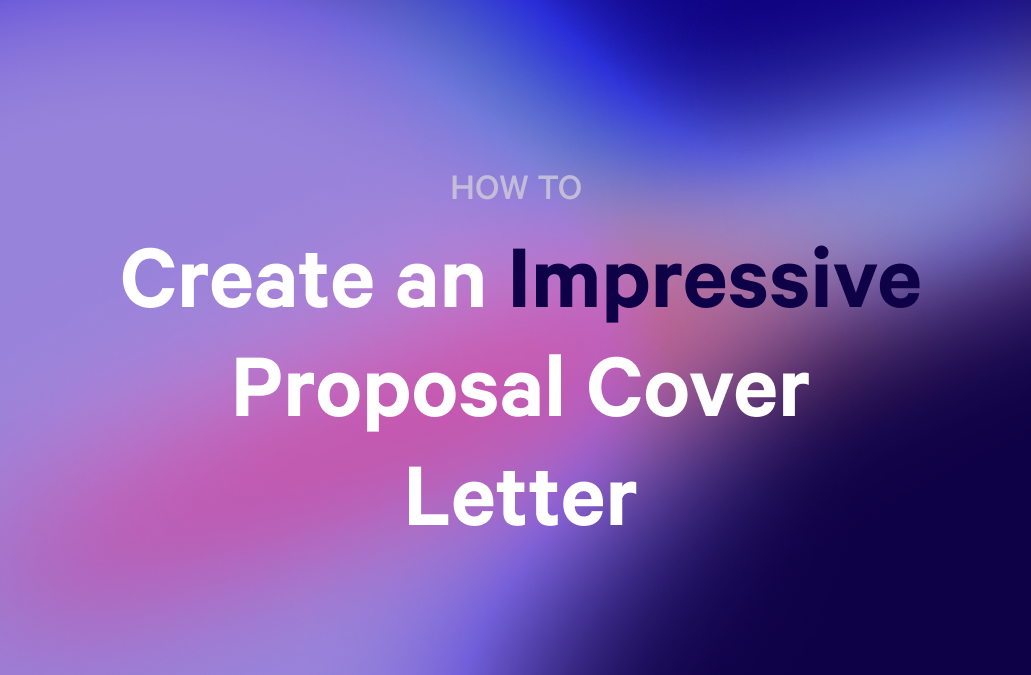In the digital age, standing out from the crowd to reach their target audience is one of the main challenges brands face. And as an influencer, that's where you fit in. With your distinctive voice and engaged followers, you help brands reach out to customers in a way that feels authentic and makes an impact.
Ironically, to reach these brands, you face this same challenge- separating yourself from other influencers to show that you are the best fit for them and their audience.
That’s why an effective influencer marketing proposal is so essential.
In this article, we'll show you the critical elements you need for an influencer marketing plan that converts, demonstrating your value with clarity and confidence.
Key takeaways
- An effective influencer marketing proposal is essential to demonstrate value and stand out from other influencers.
- A successful proposal requires understanding the brand’s needs and aligning them with the influencer's unique proposition.
- Sharing audience demographics and insights, highlighting previous campaigns, and outlining a specific collaboration proposal are key elements of the proposal.
- The proposal should also include a clear strategy and execution plan, define success metrics, and share budget details.
- The proposal concludes with a call to action, encouraging the brand to take the next step.
What is an influencer marketing proposal?
Influencers need a marketing proposal to show companies the benefits of a potential collaboration for their marketing goals.
It's a way to introduce yourself to the brand with a comprehensive plan summarizing your particular talents and reach, the characteristics of your followers, and how they align with the brand's goals.
For a successful proposal, you need to steer clear of a generic, scattershot approach and take the time to understand the brand’s needs and how your unique proposition can help fulfill them. In this proposal, you talk about why your followers trust you, how you connect with them, and how the brand can benefit from this connection.
You can see our influencer proposal template in action below.
Steps to write an influencer marketing proposal: Key elements to include
With a mix of creative ideas and thoughtful planning, your proposal can open the door to new and exciting projects. In this part, we'll guide you through the essential steps to ensure your proposal grabs a brand's attention and speaks to them in a way that sparks genuine interest, no matter which sales methodology you are following.
Read next: How to create a content marketing proposal
1. Introduction to you and your brand
This is where you look to build a connection, telling your story in a way that connects deeply with the brand you want to work with
Start by talking about the core of your brand. What motivates you? What do you want to achieve? You want to paint a vivid picture of yourself, not just as a content creator but also as a person.
Then, emphasize what makes your personal brand unique. Talk about your specialty, your style, and how you connect with your audience uniquely. Brands are looking for influencers with an engaged, active audience because that's the key to effective partnerships.
You need to convince them that you can create content that grabs attention and inspires people to take action, and it all starts here, in your written sales proposal.
2. Demonstrate your understanding of the brand's needs
This part of your sales proposal is your chance to show the brand that you understand their current situation, what they need, and who they want to connect with.
You need to show that you haven't just taken a token look at their website and fired off an email but have taken the time to dig deep and really find out their challenges & goals. Talk about where the brand stands in its market, what obstacles it faces, and how it differentiates itself from its competitors. Then, connect this understanding to how you can help them overcome these challenges or take advantage of new opportunities.
Remember to address the brand's dreams for the future. If you show that you know where they want to go, you're the one who can lead them there.
3. Share audience demographics and insights
Here, you talk about the different age groups that follow you, where they come from, what interests them, and how they behave online. Don't limit yourself to just giving numbers. Explain what excites your target group, what they stand for, and how they interact with your posts. This shows the brand a vivid picture of a real community, not just a group of potential customers.
This is also the perfect place to highlight what makes your followers special. Perhaps they're particularly environmentally conscious or want to keep up with the latest technological developments. Sharing these details will give the brand ideas on how to tailor the messages or products they want you to promote to the preferences of your target audience.
4. Highlight previous campaigns and success stories
Here, you turn numbers into stories that attract attention. You prove that you aren't just any influencer but a valuable partner for brands who want to connect with your audience.
Start by highlighting a few campaigns that show what you can do. For each campaign, explain the goal, how you achieved it, and what happened. Whether you wanted to make more people aware of a brand, increase sales, or launch a new product. You should report on your creative approach, the content you created, and the results you achieved. You must provide concrete data, such as how much engagement has increased, how high the sales figures are, or how many followers you have gained, to give a clear picture of your impact.
You should also explain why these campaigns resonated so well with your audience. Was it the authentic way you told the story, a new way of using a social media platform, or a creative strategy that got people talking? These stories add depth to your successes.
5. Outline your proposal for collaboration
This is where you outline your specific plans for working with the brand. Begin this section by reminding them what their goals are, based on your understanding, and then present your ideas for the campaign to help achieve those goals.
You should present customized, carefully considered strategies based on what you do best and what your audience loves. These strategies should then be tailored to the specific needs of the brand. Whether it's engaging Instagram stories or a dedicated YouTube video series, be as detailed as possible in your suggestions.
You should also justify why these activities resonate with your followers and how they'll help the brand achieve its goals. Draw on the insights you've previously shared about your target audience and use this knowledge to make a compelling case for your strategy.
6. Share your strategy and execution plan
Here, you turn your big ideas into a clear plan of action. You'll provide a detailed plan that shows every phase of the campaign, what you'll do at each step, the type of content you'll create, and where you'll share it. You must also discuss the timeline, highlighting essential moments in the campaign and when you aim to hit those milestones.
Then, talk about the nitty-gritty of making content. Explain the content (like videos, blog posts, or social media updates) that will work best for the campaign's goals and why you think so. Share how you plan to tell stories and engage your audience. Highlight how these methods will grab the audience's attention and excite them about the brand's message.
When you get into how to implement the plan, emphasize that you're ready to be flexible. Make it clear that while you have a detailed plan, this is a proposal and a jumping-off point; you're also prepared to tweak things as you go based on their feedback and then how well different parts of the campaign are doing.
7. Define the metrics of success: Measurement and reporting
This is where you talk about how you'll track the campaign's success and keep the brand updated on how things are going.
Begin by listing the key performance indicators (KPIs) you'll use to measure how well the campaign is doing. These might include:
- How many people are interacting with the content
- How many people visit the brand's website because of the campaign
- How many sales are made
- How many new followers are gained
Make sure to connect these metrics directly to what the brand wants to achieve, showing that you understand what success means to them.
Then, explain how and when you'll share these updates with the brand. Talk about whether you'll send them weekly emails with updates, give them access to a dashboard to see stats in real time, or provide a detailed report after the campaign is over. Be clear about how you'll ensure they're always in the loop.
8. Share the budget, terms & conditions
Here, you'll discuss the financial details and the rules of cooperation. This is important because it clarifies the practical side of your collaboration, showing what the campaign will cost and how things will work.
First, break down the proposed budget. Explain what each part of the budget will be used for, such as creating content, paying for ads, or other costs. Then, explain why each expense is necessary and how it contributes to the campaign's goals.
Establish the terms of collaboration with your partner. This includes discussing the payment schedule, content ownership, permissible use, and exclusivity rules. By clearly defining these terms, you can avoid misunderstandings and ensure the partnership is equitable for both parties.
9. Conclusion and call to action
This is your chance to make a final impression on the brand, summarize the most important parts of your offer, and encourage them to take the next step.
You should briefly go through the key points of your offer again. Remind the brand how well you understand what they're looking for, your plan for the campaign, and the real benefits of working with you.
Next, tell the brand exactly what you want them to do next. Whether setting up a meeting, calling you, or responding to your email, make it clear and straightforward.
Example: Influencer marketing proposal template
The influencer marketing process might initially seem daunting, especially if you're just starting. But here's something to make it easier: Qwilr’s Influencer Marketing Proposal Template.
It's simple to use and easy to customize with your unique strengths and the exciting opportunities you offer to brands.
The best proposal templates make your sales process smoother and more effective. Qwilr's templates are no exception.
Our influencer proposal template includes the following.
- Introduction: Start by introducing yourself. This is your chance to connect, share your journey, and explain why you're excited about possibly working with the brand.
- Understanding Your Needs: Here, you show you've thought about what the brand is looking for and how you can help. You're not just any influencer; you're someone who's done their homework and has ideas that align perfectly with the brand's goals.
- Audience Demographics and Insights: This section is all about your audience. You'll share details such as their demographics and engagement rate, proving why they're a perfect match for the brand's target customers.
- Previous Campaigns and Success Stories: Think of this as your highlight reel. You'll talk about your past work with other brands and the results you got. It's proof that you know how to make a campaign successful.
- Proposal for Collaboration: Now, you get into the heart of your pitch, sharing your specific ideas for working together. You'll outline the kinds of content you think will hit the mark, from Instagram stories to YouTube videos, and why they're a good fit for the brand's goals.
- Strategy and Execution Plan: This is where you dive into how you'll bring your ideas to life. You'll lay out a step-by-step plan, including what types of content you'll create, how you'll engage your audience, and the timeline for everything.
- Measurement and Reporting: It's essential to show how you'll track the campaign's success and keep the brand updated. Talk about the metrics you'll use to measure success and how you'll report back on the campaign's progress.
- Budget: Being open about costs is crucial. Explain how much the campaign will cost and where that money goes. Make sure the brand understands the value they're getting for their investment.
- Terms and Conditions: This section covers the details like payment terms and who owns the content. It's about ensuring you and the brand know what to expect and agree on how things will work.
- CTA (Call to Action): You'll wrap up your proposal by encouraging the brand to take the next step, whether meeting to talk more or just getting in touch.
- Conclusion: Ending positively, you'll highlight the benefits of working together again, leaving the brand excited about the possibilities.
Alternatively, you can use Qwilr's AI proposal generator to build a professionally-designed proposal template in minutes.
Final Thoughts
Creating a compelling influencer marketing proposal is crucial to communicating the value of what you offer to brands. While it can be tricky to master, you’ll be on the right track with these tips in mind.
Why not try our Influencer Marketing Proposal Template too? Aside from the obvious time savings, they provide a Wow factor to separate your pitch from the pack further. Try it for yourself today.
About the author

Brendan Connaughton|Head of Growth Marketing
Brendan heads up growth marketing and demand generation at Qwilr, overseeing performance marketing, SEO, and lifecycle initiatives. Brendan has been instrumental in developing go-to-market functions for a number of high-growth startups and challenger brands.
Frequently asked questions
The best format for an influencer marketing proposal is simple and clear. It should include key sections such as details about the target audience, highlights of past campaigns, a detailed strategy, the budget, and a clear CTA.
Your proposal should be long enough to cover all the essential details without overwhelming the reader. Strive for clarity and concision, focusing on the benefits you bring and the details of your plan. Five to eight pages is usually enough.
Including images, videos, or links to previous campaign content can make your proposal more dynamic and memorable. This allows the brand to get an idea of the impact of your work and get a better impression of your style and skills.

